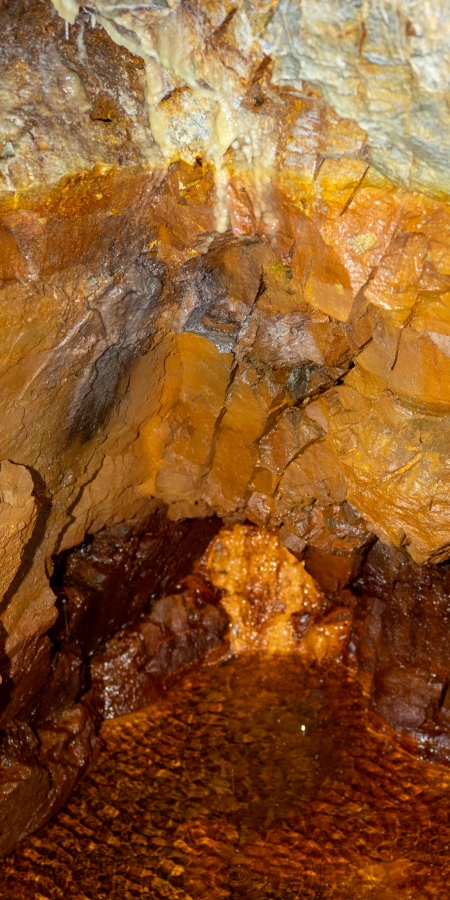Bubbling secrets
Interesting facts about mineral water


How is mineral water formed?
Meteoric water (rain and meltwater) can penetrate underground through fissures, cracks, pores and karst openings. The route the groundwater takes determines wheter the water reaches the surface as «ordinary» drinking water or as «highly mineralised» mineral water. The spring usually emerges at the lowest point where erosion has exposed the rock – usually near the bottom of a valley. The mineral water of Lower Engadin comes from Graubünden shale. Therfore, its degree of mineralisation depends on the following factors:
- how long the water spent in the rock underground
- the depth the water penetrated to
- the pressure and temperature conditions resulting from this depth
If, at great depths, groundwater or fissure water meets carbon dioxide gas rising due to the activity of magma or carbon dioxide gas produced by rock metamorphosis, it becomes enriched with it, producing naturally carbonated water. The water dissolves various elements from the ground, such as sodium, calcium, magnesium, potassium, iron, chloride or sulphate, depending on the rock through which it flows. It usually takes many years or decades for the water to become mineral water. The mineral springs in the area around Scuol come to the surface as cold springs (5 – 10 °C). The water in the Carola, Vi, Sotsass and Lischana springs spends about five years underground. Meanwhile, the water in the Lucius, Emerita, Sfondraz and Bonifacius springs needs about 25 years to «mature».
Ground water circulation
Types of spring
The «healing springs» first mentioned in writing in 1369 and highly praised by Paracelsus in 1533 can be divided into groups based on their most important ingredients.
Overview of types of spring
| Types of spring | Springs |
|---|---|
| Naturally carbonated mineral water with calcium, hydrogen carbonate (and iron) | Chalzina, Chalzina Sura, Clozza, Fuschna, Rablönch, Runà, Sotsass, Tulai, Vi |
| Water with calcium & sulphate | Funtana Cotschna |
| Naturally carbonated mineral water with calcium, sodium, hydrogen carbonate & iron | Bonifacius |
| Naturally carbonated mineral water with sodium, calcium, hydrogen carbonate, chloride (arsenic & iron) | Carola, Sfondraz, Ulrich |
| Naturally carbonated mineral water with sodium, hydrogen carbonate, chloride & iron | Emerita, Lucius |
| Naturally carbonated mineral water with sodium, magnesium, hydrogen carbonate, sulphate & iron | Lischana |
| Types of spring | Naturally carbonated mineral water with calcium, hydrogen carbonate (and iron) | Water with calcium & sulphate | Naturally carbonated mineral water with calcium, sodium, hydrogen carbonate & iron | Naturally carbonated mineral water with sodium, calcium, hydrogen carbonate, chloride (arsenic & iron) | Naturally carbonated mineral water with sodium, hydrogen carbonate, chloride & iron | Naturally carbonated mineral water with sodium, magnesium, hydrogen carbonate, sulphate & iron |
|---|---|---|---|---|---|---|
| Springs | Chalzina, Chalzina Sura, Clozza, Fuschna, Rablönch, Runà, Sotsass, Tulai, Vi | Funtana Cotschna | Bonifacius | Carola, Sfondraz, Ulrich | Emerita, Lucius | Lischana |

Components
The captured mineral waters contain a wide variety of components that are indispensable for humans. The most important minerals are listed here with their characteristics.
Overview of the components
| Mineral | Characteristic |
|---|---|
| Chloride | Chloride contributes to normal digestion through the formation of gastric acid. |
| Iron | Iron in dissolved form contributes to the normal formation of red blood cells and haemoglobin and thus to normal oxygen transport in the body. It also contributes to the normal function of the immune system and to the reduction of fatigue. The average daily requirement of an adult is 14 milligrams. |
| Calcium | Calcium is needed for the maintenance of normal bones and teeth. It contributes in dissolved form to normal energy metabolism, normal muscle function, blood clotting and signal transmission between nerve cells. The average daily requirement of an adult is 800 milligrams. |
| Magnesium | Magnesium is needed for the maintenance of normal bones and teeth. In dissolved form, it contributes to normal muscle function, the nervous system and the reduction of fatigue. The average daily requirement of an adult is 375 milligrams. |
| Mineral | Chloride | Iron | Calcium | Magnesium |
|---|---|---|---|---|
| Characteristic | Chloride contributes to normal digestion through the formation of gastric acid. | Iron in dissolved form contributes to the normal formation of red blood cells and haemoglobin and thus to normal oxygen transport in the body. It also contributes to the normal function of the immune system and to the reduction of fatigue. The average daily requirement of an adult is 14 milligrams. | Calcium is needed for the maintenance of normal bones and teeth. It contributes in dissolved form to normal energy metabolism, normal muscle function, blood clotting and signal transmission between nerve cells. The average daily requirement of an adult is 800 milligrams. | Magnesium is needed for the maintenance of normal bones and teeth. In dissolved form, it contributes to normal muscle function, the nervous system and the reduction of fatigue. The average daily requirement of an adult is 375 milligrams. |
Comparison of selected components
Sfondraz spring with commercially available mineral waters


Brochure «The Mineral Springs of Scuol and Surroundings»
In this brochure you will learn a lot of interesting facts about the mineral springs in and around Scuol and their importance for Lower Engadine spa tourism. (In German)
